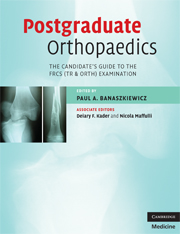Book contents
- Frontmatter
- Contents
- List of contributors
- Foreword by Mr Peter Gibson
- Preface
- Glossary
- Section 1 The FRCS (Tr & Orth) examination
- Section 2 The written paper
- Section 3 The clininicals
- Section 4 Adult elective orthopaedics oral
- Section 5 The hand oral
- Section 6 The paediatric oral
- Section 7 The trauma oral
- 23 Trauma oral topics
- Section 8 The basic science oral
- Section 9 Miscellaneous topics
- Index
- References
23 - Trauma oral topics
from Section 7 - The trauma oral
Published online by Cambridge University Press: 22 August 2009
- Frontmatter
- Contents
- List of contributors
- Foreword by Mr Peter Gibson
- Preface
- Glossary
- Section 1 The FRCS (Tr & Orth) examination
- Section 2 The written paper
- Section 3 The clininicals
- Section 4 Adult elective orthopaedics oral
- Section 5 The hand oral
- Section 6 The paediatric oral
- Section 7 The trauma oral
- 23 Trauma oral topics
- Section 8 The basic science oral
- Section 9 Miscellaneous topics
- Index
- References
Summary
Introduction
The original plan was to write a concise account of orthopaedic trauma that would be all things to all candidates about to sit the FRCS (Tr & Orth) exam. The reality is that there are a lot of very good concise orthopaedic trauma textbooks available (to read and revise from). Therefore, what follows is an attempt to present an overview of the trauma oral section to give a candidate a flavour of what to expect. At the end of the chapter we discuss possible trauma long cases. Trauma long cases can be awkward as they usually involve complex management issues often secondary to complications from initial trauma care.
Differing oral styles
Many candidates regard the trauma oral as the easiest oral to pass. Perversely a fair number of candidates have come out of it saying it was the worst one of the lot. There seem to be broadly four styles of trauma oral that you may encounter in the examination:
The classic trauma oral: A series of fast-moving slides where you describe the injury and your preferred method of management. There is barely enough time to catch your breath before the next slide is shown. This type of oral covers a lot of ground very quickly but the discussion is fairly superficial. It can be an enjoyable oral if you know your stuff well
>The probing trauma oral: The trauma oral where fewer slides are shown but the questions are more detailed and a more thorough answer is expected. Usually it contains one or more of the dreaded “describe the surgical approach you would use to fix this fracture” type of question
[…]
- Type
- Chapter
- Information
- Postgraduate OrthopaedicsThe Candidate's Guide to the FRCS (TR & Orth) Examination, pp. 403 - 458Publisher: Cambridge University PressPrint publication year: 2008

